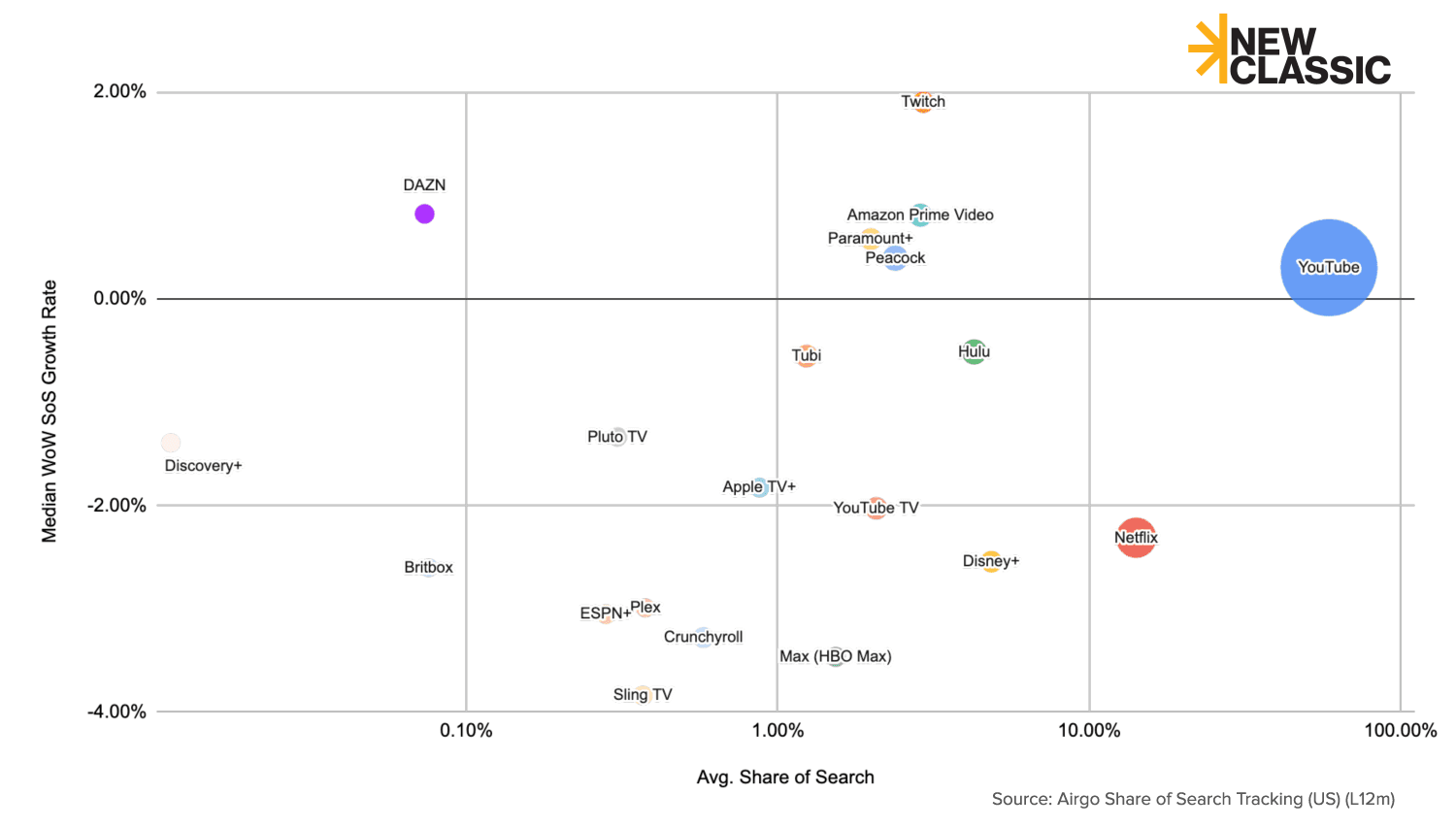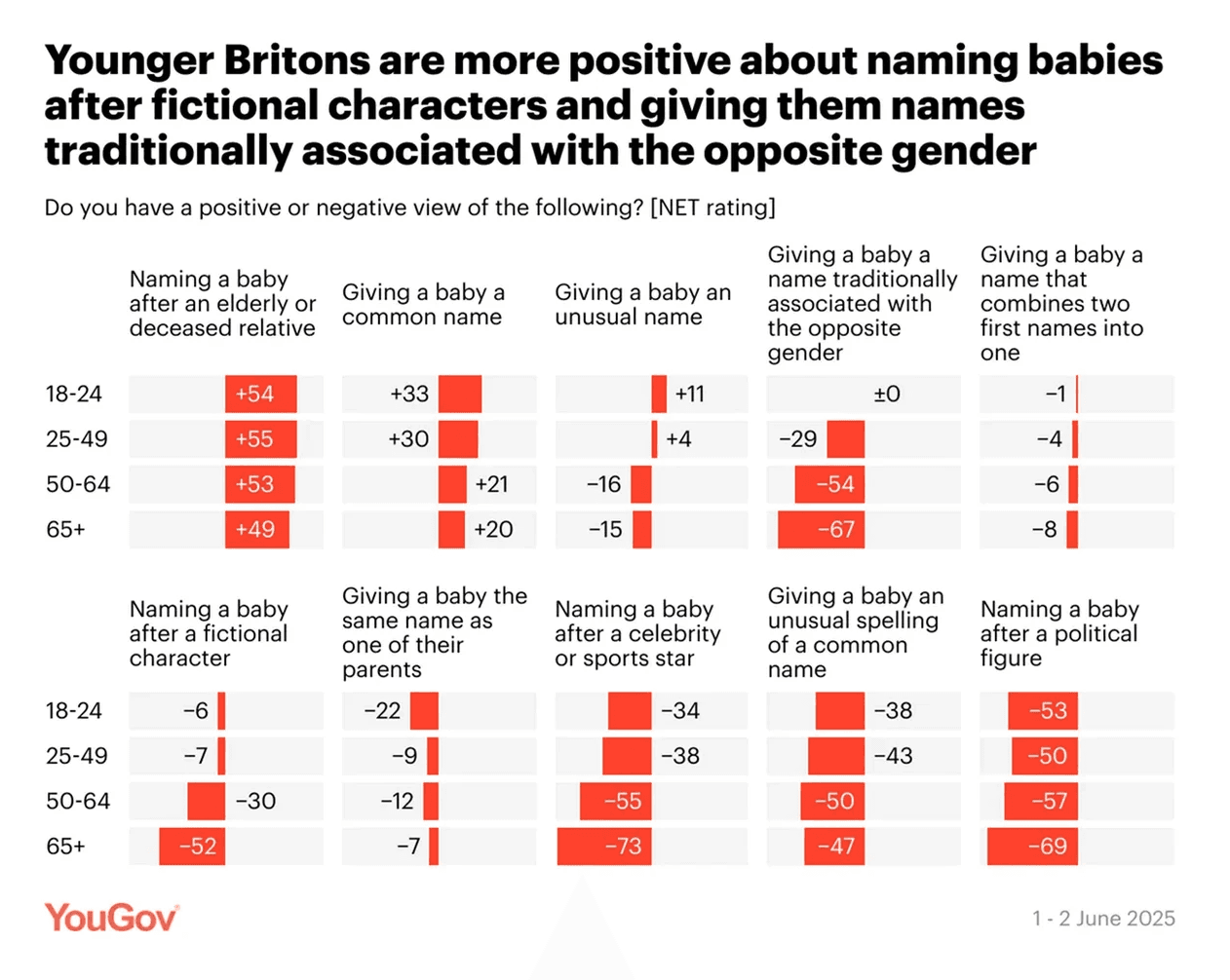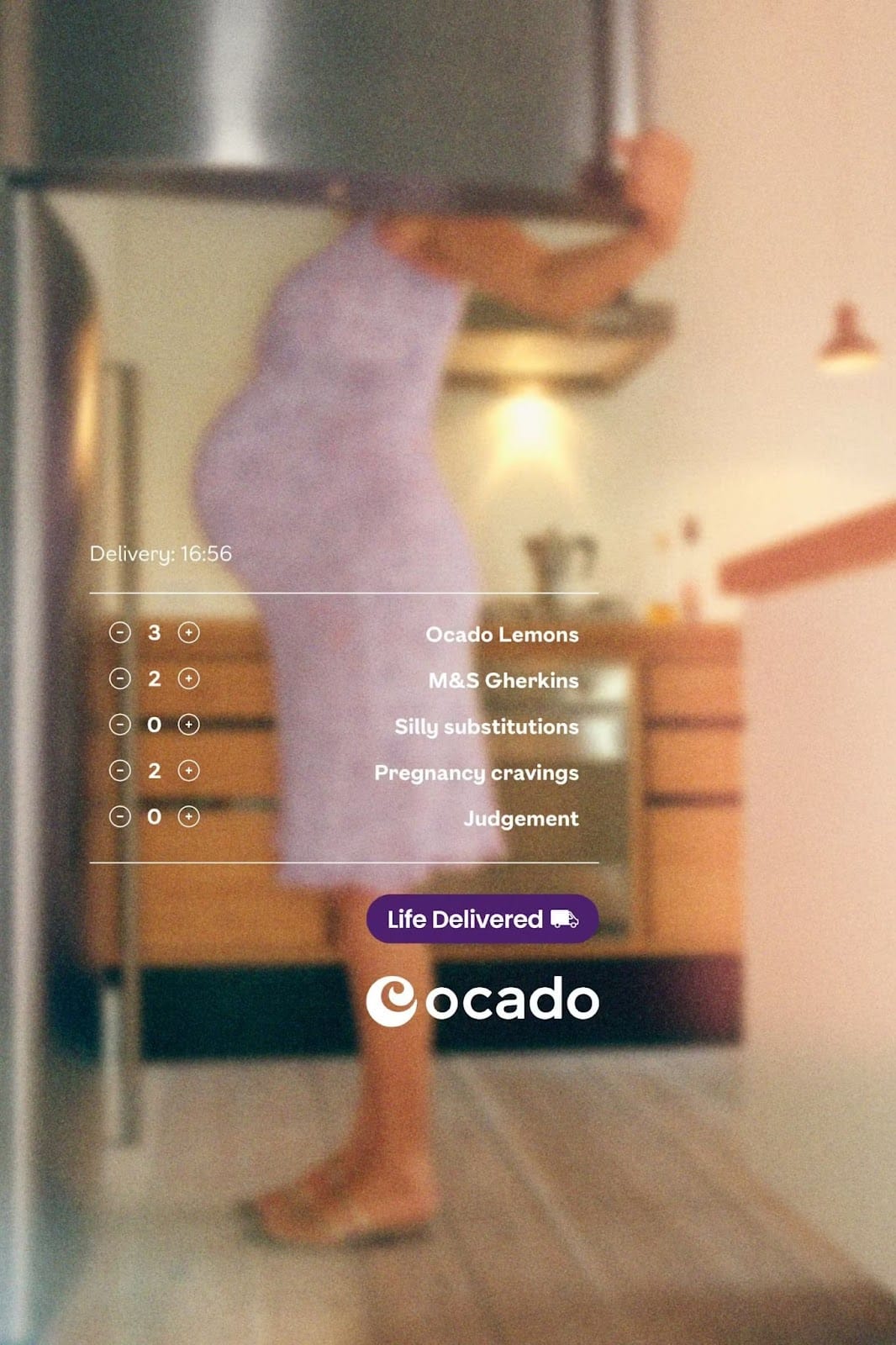In this issue of Sunday Strategy, we look at five stories to think about next week, including: Rose Tinted Ads, AI Music’s Uncertain Hit, The Two Brand Streaming Wars, The Canary in the Economic Coal Mine and How Brits Name Babies.
In addition, we have ads from: HOKA, Apple, Ocado, Duracoat.
// Stories of the Week:
1.) Rose Tinted Advertising: When Ads Dodge Reality
Advertising has the power to change the world around it, but it also runs the risk of seeing the world it wants vs. the world as it exists. ‘Rose Tinted’ advertising is all around us, as misaligned ads espouse features no one wants or claims no one believes. It doesn’t often stem from an intentional lapse in client or agency judgement, but instead a disconnect between the potential of creativity and the reality of strategy.
From Southwest Airlines’ latest ad campaign, championing ‘seat reservation’ in the face of ditching their beloved DIY seating policy, to Starbucks’ forced move to drive employees to write messages on cups, in an attempt to reclaim a third space, or Heathrow Airport’s recent album made to ‘relax’ travellers, as opposed to focusing on the relaxation of a continually refined airport experience – creativity is being asked to avoid and paper over challenges that could be otherwise addressed. Three hours into an airport delay, no level of musical production is going to help. Minutes added to a coffee run don’t go away with a ‘hello’ on the cup. A brand’s key differentiator can’t be realigned in a single ad.
Real change is made when brands tackle issues head on with creativity, directing its potential to a realistic view of a challenge. We need to anchor advertising in the real world or consumers will do it for us (just ask Jet2 and the stream of travel content using their jingle on TikTok).
2.) Your New Favorite Band Doesn’t Exist.
60s style rock band ‘The Velvet Sundown’ has amassed over a million streams on Spotify, but they don’t exist. As AI music has further developed, with sites like Suno navigating an onslaught of lawsuits and brokering licensing deals, it was inevitable that the line between human and AI generated music blurred in ways like this.
Though public taste on AI generated music has yet to fully define itself, ‘The Velvet Sundown’ shows that artists and platforms have to shape their policy on AI music now. While some platforms like Deezer and ROKK have banned AI music, Spotify and others have been more permissive.
Subsequently, consumer response is so far uncertain. A 2024 YouGov study shows US consumers are concerned about a lack of originality, ethical issues and legal implications, with 47% of Americans saying they were uninterested in AI generated music. Whether this represents true opposition or the absence of a proper push into the possibility of the technology is open to debate, especially as half of Gen Z say they’re open to AI music and their favorite artists using it. Suno is undeniably an intriguing hub of music at the moment and new features allow artists to upload actual music to build on it.
The largest issue may not be AI use, but clear labelling of it. 90% of consumers want clear labelling for AI music and 66% believe that they can’t spot AI generated music. Uncertainty around if ‘The Velvet Sundown’ exists may be tapping into this uncertainty as much as the wider issue of AI generated music. With clarity on the artist, artificial musicians may have a better chance at establishing themselves. While the lack of humanity may seem to limit fan relationships, synthetic concerts like London’s ABBA Voyage show that artificial music may have avenues to build real relationships across listening and even live experiences in the future. Either way, my AI country and rock hit about my dog and this Eurovision style banger about Greenpoint Brooklyn have yet to turn into a world tour (but I am available for Glasto 2027).
3.) Have the Streaming Wars Come Down to Netflix & YouTube?
Netflix once famously said its largest competitor is sleep, but in recent years, the streaming wars have arguably reduced down to two brands (Netflix and YouTube) with very different strategies. While Netflix has always aimed to make longer, more intentional content and YouTube has been a home for video content of all lengths, formats and quality – the line between the two has blurred. Netflix has recently begun signing YouTube creators for content development deals, while YouTube has been focused on refining the algorithm to serve up a more entertaining experience. So can both coexist?


If anything, the two have historically fought slightly different, but tangential battles, as Netflix attempts to leverage spikes in interest to maintain subscriptions while YouTube aims to own smaller, daily moments of attention. As both the NYT and our own Airgo Share of Search tracking highlight, each is more focused on the other than any additional competitors and as Netflix shifts towards everyday presence the battle lines are becoming more defined. Each has a traditionally stronger media channel (TV for Netflix vs. Mobile for YouTube), but increasingly want the same audience. Content and expansion across media channels may be where the next chapter in this battle is fought.
4.) Is This a Canary in the Economic Coal Mine?
New Harris Poll research has shown that disproportionate female economic anxiety may be a ringing alarm bell about the state of the economy. While economic uncertainty is rife in many polls, Gallup has found that 70% of women say ‘financial health’ is all they think about today and 62% say the economy is worsening (vs. 47% of men).
The research proposes that as the unofficial CFOs of many households, women’s financial worry may reflect different financial indicators, moving more towards daily purchase, cost of living and ‘recession prep’ vs. wider macroeconomic indicators that have painted a rosier picture. With greater financial worry and engagement, are we poised to see more brands tap into addressing this greater level of anxiety amongst women?
// Chart of the Week: What’s in a British British Name? It Changes by Generation.


While the impact of our names on our lives, called nominative determinism, has yet to be fully agreed – a recent YouGov study in the UK shows how Brits feel about certain baby names and their sources, which breaks down by generation. While naming a baby after an elderly or deceased relative is popular across age ranges, younger Brits are less negative about challenging gender roles or spelling vs. older groups. In fact, while still resistant to both, 18-24s would be more likely to name a baby after a fictional character than they would one of their parents.
// Ads You Might Have Missed:
1.) ‘Together, We Fly Higher’ – HOKA:
While running may seem like a solitary act, the community and supporters around a runner change the dynamics of any run. From a 5k to an ultra-marathon, the person or people behind a runner become an integral part of any run (and for anyone who’s tried to see a friend do a race, tend to go on their own run to find them). HOKA’s latest campaign taps into the sense of community and support in modern running, showing vignettes of runners being supported before, during and after a range of races.
The ad, beautifully soundtracked by Bob Dylan’s ‘Shelter from the Storm’ acknowledges that we often don’t run alone, be it alongside other runners or with friends, family and the running community cheering us along. It makes support as aspirational as finishing the race in a way that taps into the social side of modern running and in the process takes something we all inherently know and puts it forward in a new way.


2.) ‘Shopping List Stories’ – Ocado:
UK delivery brand Ocado’s latest campaign takes the shopping list and uses it as a narrative device to show where the brand fits into life’s moments. ‘Shopping List Stories’ features OOH ads that feature item lists adding up to life moments big and small, from sneaking a taste of cake through to pregnancy and proposals. The campaign subtly ties together a delivery and item message with emotional story telling into a fast moving package that reminds Brits what it can deliver for any of life’s moments, substantiating their ‘Life Delivered’ brand platform well.
3.) ‘El Lazo De Petra’ – Apple:
Apple’s latest ‘shot on iPhone’ film takes a mixed media approach to tell the story of Petra, one of the best charras ever in Mexico. The story, framed as being passed between a grandmother and granddaughter continues to show the capabilities of the iPhone to capture footage, but does it in a way that departs from traditional shots to integrate 8-bit video game footage and more, putting ‘shot on iphone’ as one aspect of the movie vs. the entire focus.
The elements of Mexican culture put within the movie, from charras to La Llorona, El Coco (The Boogeyman), and the Chaneques (Aztec goblins) tie together an emotional story about women’s bravery, family and culture- to make it feel more than another camera demo. Instead, it serves as a reminder of the creativity iPhone supports with and beyond itself.
4.) ‘If You Miss It, You Mess It’ – Duracoat Aquatech Rainshield:
Waterproofing is something most people don’t think about until it’s too late, and the category standard of product demo ads does little to change this until a customer is already engaged. Kenya’s Basco Paints company challenges this in their launch ad for Duracoat Aquatech Rainshield, their first waterproof tintable paint. Featuring two duelling product sales people riding through town, a product demo has been swapped for the fantastical, as Duracoat’s driver is able to part a river using the presence of the product while his competitor fails. While the ad may be more Moses than Ronseal, the unreal ‘demo’ looks to engage in a way more rational messaging may not.
// Sunday Snippets
// Marketing & Advertising //
// Nike Football extends its ‘scary good’ campaign to the Dutch Women’s team through tulips with thorns [Ads]
// Canal+ claims to have made an AI watch months of TV in its latest ad. Probably better than whatever Groq’s been watching. [AI]
// Honey Pot’s latest ad tries to highlight the reality of periods to show that they don’t need to be perfect, just better [Ads]
// Microwavable burger brand Rustler’s wants to trap you in a ballroom of taste that feels very David Lynch [Ads]
// 7-11’s tongue tattoo for ‘Slurpee Day’ is the focus of a goth family’s outrage in a new ad [Ads]
// The Alzheimer’s Foundation uses ‘buffering’ as a metaphor for the disease in a new campaign [Ads]
// Kraft Heinz eyes a split of its brand [Business]
// Technology & Media //
// Nike has quietly launched on Substack [Social Media]
// Four have been arrested in connection with the M&S and Coop cyber attacks in the UK [Technology]
// Hims & Hers are going to offer a generic semiglutide in Canada thanks to a Novo Nordisk patent lapse [Health]
// CDN and cyber security service Cloudflare announces they’ll block AI crawlers by default [Technology]
// As she departs X, could Linda Yaccarino ever have succeeded? [Social Media]
// Life & Culture //
// The new Superman movie has sparked calls of ‘wokeness’ from the American right, but what’s the reality of the film and the franchise? [Film]
// How TikTok’s #morningshed went viral [Beauty]
// Late career job losses are blurring what retirement looks like in America [Work]
// Maybe we should give NBApaint’s new Toronto Raptors logo a chance? [Sports]
// ‘The All American Rejects’ announce a backyard house party tour, with the opportunity for fans to submit a venue [Music]
// Until Next Sunday
As always, let me know what you think by email (dubose@newclassic.agency), website or on LinkedIn.
You can also listen to an audio summary and discussion of each week’s newsletter on Spotify. We’re also on TikTok!





